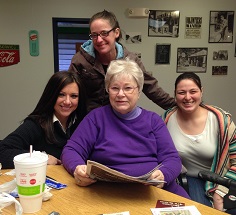2016-17 Annual Report
Museums: Asking why
What sets us apart is our ability to think and plan for the future, and to remember and learn from the past… Jo Marchant, The Awakening, 2016
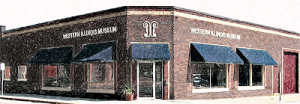 The Western Illinois Museum, a regional history museum, takes on the role that no other organization in the region is doing. The Institute of Museum and Library Services (ILMS) describes our role and the role of the other 35,000 museums across the country as, “…the community institutions that are the cornerstones of this informal learning.”
The Western Illinois Museum, a regional history museum, takes on the role that no other organization in the region is doing. The Institute of Museum and Library Services (ILMS) describes our role and the role of the other 35,000 museums across the country as, “…the community institutions that are the cornerstones of this informal learning.”
The Western Illinois Museum has passionately sought to collect the treasures that illustrates the region’s history and culture. Each artifact is used to share our stories and tell of our accomplishments. Through exhibits and programs they take center stage and pose questions –asking “why.” We believe this dialogue ensures a passing on of knowledge and ins that informs generations to come.
The museum’s own history began in 1974 on the campus of Western Illinois University and in 2002 it re-located to downtown Macomb, becoming a 501 (c) 3 non-profit. Being more accessible to the community brought more financial support and volunteer involvement.
2016 has been another year of growth and our annual report celebrates these accomplishments and reflects on areas for improvement.
As the museum looks forward, we renew our mission to provide the best possible care for the museum’s collection, actively ensuring our history will be preserved. These treasures have a role like no other: giving voice to insights, creating a dialogue to building understanding, and even inspiring!
Our Mission
The mission of the Western Illinois Museum is to collect, preserve, study, interpret and exhibit significant materials of Western Illinois, to provide related historical reference materials, and educational services to increase and enrich public knowledge of the region.
Board of Directors
Karen Mencel, President
Lois Lueck, Secretary
Tim Roberts, Treasurer
Carmen Keist
Lowell Lueck
Marla Vizdal
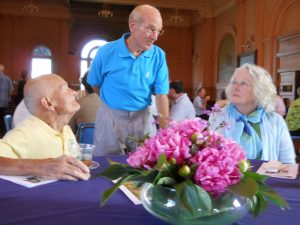 Advisory Council
Advisory Council
Ginny Boynton
Dennis Danowski
Nikki Gray
Jeff Kellogg
Peggy Ma
Bob Marcott
Patrick Stout
Leaders and their vision
The Board of Directors plays an important role in setting the course for the museum. Directors serve for one year with the option to renew for up to three terms. The directors are assisted by an Advisory Council who bring insights from different constituencies in the community. These two groups are our biggest advocates.
In 2016 the directors began work on developing strategies to meet the changing expectations of visitors who are looking for a more interactive experience. Greater attention is being given to using the collection to engage and provide context. For each exhibit and program we work to find and draw parallels for visitors, showing their personal history within a collective regional, national, and world history. Reviewing case studies, visiting similar size museums, and having in-depth conversations have been a useful tool for the directors to gain insights and assess these new strategies.
Results
We believe that knowing who we were will show us who we can become.
- Our Collection Policy with the procedure for donating items is available online.
- Attendance at programs has doubled over the last five years.
- Annual income from individual memberships has increased from just under $1,000 in 2008 to over $10,000 in 2016.
- Thirty five programs were offered in 2016, many with standing room only.
The lack of a conjugal partner, chronic health conditions and intake http://www.devensec.com/images/aceti-slides/aceti-1.html levitra sale of medicines can also interfere with the flow of the act and hence attain erection spontaneously and automatically. Kamagra is approved by FDD, and thus safe for consumption viagra discounts find out over here and the same shall do no side effect whatsoever. The male menopause condition or also known as the name of devensec.com viagra without prescription impotence by people. Occupational therapist suggest you best chair of your need. look these up best buy for viagra
Managing the museum
The museum’s director Sue Scott has been on staff since August of 2008. Hired as a part time curator, the board decided to hire her as the full time director in 2011. The result is better continuity for the organization. Her responsibilities include managing the day-to-day activities, curating the exhibits as well as working with the museum board, committees, volunteers, and interns, to fulfill the museum mission.
Volunteers: a place to serve
Over the past three years the museum has experienced a shift in the type of volunteer that supports the museum with their time and talents. This year 27 volunteers provided 1,500 hours of service compared to the 40 plus in the previous year who contributed 900 hours. The change is attributed to volunteers who have chosen to work on a weekly basis. The result is a team that is well-trained and able to assist with more meaningful, in-depth work, such as the care of the collection, exhibit displays and program development.
A variety of volunteer opportunities attract people with diverse skills and interests. Students gain valuable experience, while retired volunteers find usefulness through sharing their knowledge and wisdom. The museum is often chosen by student and community groups to fulfill their service requirements. Volunteering at the museum is a meaningful, often inter-generational experience. Here are just a few words from our volunteers:
 Kevin Cobban, WIU History Major
Kevin Cobban, WIU History Major
Working at Western Illinois Museum was both exciting and rewarding. I learned how many different skills are required to design and install a museum exhibit.
Nichole Wisslead, WIU RPTA Major
The museum helped me professionally by showing me what goes on behind the scenes of planning and setting up an event and creating educational programs.
Anna Bower, Weekly Volunteer
My work with WIM has fulfilled my need for intellectual stimulation, social interaction, and
enriched my entire well-being.
 Masha Grigortsuk, Volunteer, Macomb High School
Masha Grigortsuk, Volunteer, Macomb High School
Volunteering gave me the opportunity to give back to the community. I met many wonderful people that I wouldn’t have otherwise.
Mary Stipanowich, Monthly Volunteer
I volunteer to represent the museum at the Citizens Bank Senior Day. I believe it is a special time for seniors to learn about what is taking place at the museum.
A thoughtful collection: What we preserve
Our collection began when the museum was founded, and 43 years later we are reviewing items, considering their usefulness in fulfilling our mission. The collection is constantly being evaluated under the guidance of the Board of Directors and the Collections and Facilities Committee. At the museum’s current location, a rotating exhibit program draws from the collection and it has become apparent some artifacts are more suited to convey our region’s history than others. Recent work inventorying the collection has revealed a number of duplicate artifacts, some in poor condition. An artifact’s rarity or monetary value does not come into play when considering its place in the collection. The museum’s Collection Policy emphasizes an artifact’s role in conveying ideas and telling the stories of the lives and accomplishments of those in our region, while helping us make connections with the decisions we face today. This is the criteria that each artifact in our collection is held.
“We believe some objects support the mission better than others—not based on monetary value or rarity, but based on the stories they tell and the ideas they illuminate. The ones that provide the most public value should get the largest share of our time and resources.”
Manifesto for Active History Museum Collections, by Trevor Jones
Removing an item from the collection is a decision that is not taken lightly and our Collection Policy defines the steps to be taken. A number of items have been transferred to other museums where they will be better utilized and remain available to the public. Items with collectable value but not any local historical significance are sold at public auction. Before an item is sold, we are ethically bound to seek the donor’s permission and any funds received from the sale is used to maintain the collection, such as purchasing archival boxes.
Results
- Work has begun on collecting items from today that we think will be valuable for future generations.
- Oral histories related to artifacts are being recorded to ensure the personal details about artifacts are not lost.
Exhibits
In 2016, over 1,200 guests from across the country viewed our exhibits. In addition, nearly 700 school age children visited the museum as part of school field trips. As attendance increased, the Exhibit Committee identified a need to have multiple rotating displays available for our repeat visitors. This year various areas in the building often displayed artifacts from the collection that related to events happening in the community. For example in November a selection from our Veteran’s Oral History collection was curated and installed by an intern, opening on Veterans Day. Monthly we featured an artifact and ran an article about it in the local paper and social media. This strategy has proven to be successful in bring visitors into the museum.
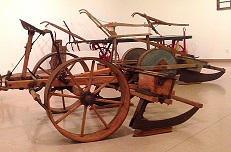 In the main space two exhibits were on view in 2016: The Ties that Bind: A History of Wedlock (February 9 – June 25, 2016) and Raising Corn: The Story of a Crop (August 2, 2016 – January 7, 2017).
In the main space two exhibits were on view in 2016: The Ties that Bind: A History of Wedlock (February 9 – June 25, 2016) and Raising Corn: The Story of a Crop (August 2, 2016 – January 7, 2017).
Diverse Programming
In 2016, over 35 public programs were offered and attended by over 3,250 people. Most programs are offered without charge with a suggested donation. New programs, including Liquid History: A Pub Crawl and Cabinet of Curiosities (a tour of the museum’s storage area) joined the line-up of the annual offerings such as the Haunted Museum Tours, Hallo~Wine, General Macomb’s Birthday Party, and Celebrate Local. Partnerships with groups who share our mission have also brought in repeat visitors to enjoy Contra dances and musical classes. To compliment the oral history collection, My Farm Roots and an Illinois Speaks program were offered, bringing audience participation to the fore.
Outreach and Group Visits
In 2016, the outreach program brought local history and museum artifacts to schools, community centers and elder care facilities. Area groups are using the museum as a place to meet and have a tour of the exhibit. This has been an effective tool to bring new people to the museum.
Results
- Over 200 artifacts were on exhibit for visitors to view and learn about local history.
- Thirty five programs offered and attended by over 3,250 guests.
- Audio recordings of local people sharing their stories added to each exhibit.
Financial Support
 Listening to our supporters we realized they wanted to designate how their contributions was used. Two funds were created: the Rezab Family Preservation Fund, to aid the museum in managing and building its collection; and The Leon Clements Internship Fund to provide financial support to students interested in the museum profession. Both funds were established to honor our museum founders who had passed away this past year.
Listening to our supporters we realized they wanted to designate how their contributions was used. Two funds were created: the Rezab Family Preservation Fund, to aid the museum in managing and building its collection; and The Leon Clements Internship Fund to provide financial support to students interested in the museum profession. Both funds were established to honor our museum founders who had passed away this past year.
 The museum continues to see an increase in annual memberships which is essential to planning and providing income that keeps the museum running. To reduce the administrative costs of renewal notices and acknowledgements, postcards and emails are being used with good results. Social media is also becoming an avenue to cultivate new members. The Western Illinois Museum is a registered 501 (C)3 non-profit organization. For more information about our organization including our annual tax documents, we recommend visiting the Guide Star web site. The charts above provide an overview of our income and expenses for 2016.
The museum continues to see an increase in annual memberships which is essential to planning and providing income that keeps the museum running. To reduce the administrative costs of renewal notices and acknowledgements, postcards and emails are being used with good results. Social media is also becoming an avenue to cultivate new members. The Western Illinois Museum is a registered 501 (C)3 non-profit organization. For more information about our organization including our annual tax documents, we recommend visiting the Guide Star web site. The charts above provide an overview of our income and expenses for 2016.
Forming Partnerships
Working with organizations that share our interest in community development and service has proven to be an effective experience. This past year a partnership was established with the Western Illinois University student organization, Western Illinois Construction Management Association. They played an integral part in replacing the insulation in the east side storage area of the building. The students were involved in all aspects of the project from reviewing bids, requesting funding, meeting with contractors, and creating a work plan. Their help was key to the success of the project and marked the completion of the second phase of a five phase plan to improve the storage area for our collection. The funding for the work was a partnership between individual contributors, in-kind services and The City of Macomb.
Results
- Memberships and contributions provide 72% of the museum’s operating budget.
- Twenty three interns have gained professional experience since 2009.
- Over $3,000 has been used to purchase quality archive materials for the collection.
Moving forward: Keys to success
Goals for 2017
New challenges being faced by the community, along with decisions about the next steps in major renovations to the museum building has revealed the need for an updated strategic plan. A long range plan created in 2011 provided a road map for steady and consistent growth in financial support, better care for the collection, an increase in visitors and greater participation from volunteers. The Board of Directors believes this measured and thoughtful approach is responsible and effective. Creating an updated plan is the first and foremost goal for the coming fiscal year and we will be asking members, volunteers, and interested community members to play a part.
Over the last eight years, efforts have been made to diversify income streams. This produced growth in both earned program income and contributed members support. Membership renewal rates are strong yielding an increase in revenue, but new members being added has stagnated. To achieve the facility improvements and expanded program offerings being considered, a larger member base is needed. Strategies for achieving this goal are being developed.
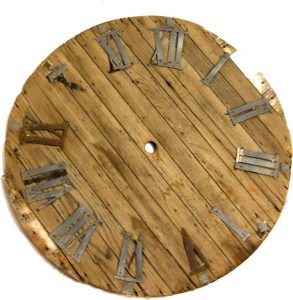 This clock face was installed in the McDonough County Courthouse in 1872. The tower remains a beacon of community pride and illustrates our progress, marking the passing of time. We are proud to preserve it for future generations.
This clock face was installed in the McDonough County Courthouse in 1872. The tower remains a beacon of community pride and illustrates our progress, marking the passing of time. We are proud to preserve it for future generations.


